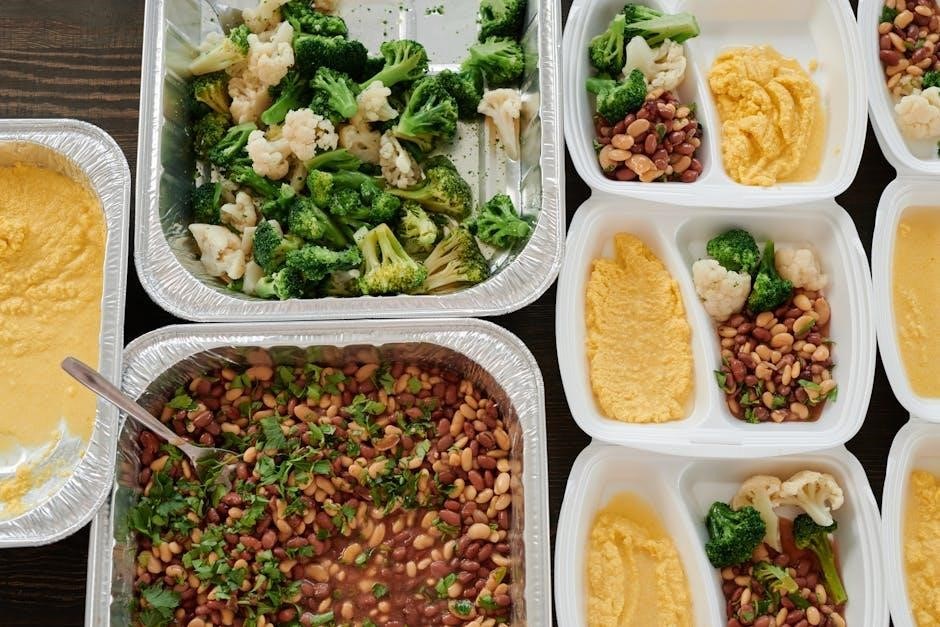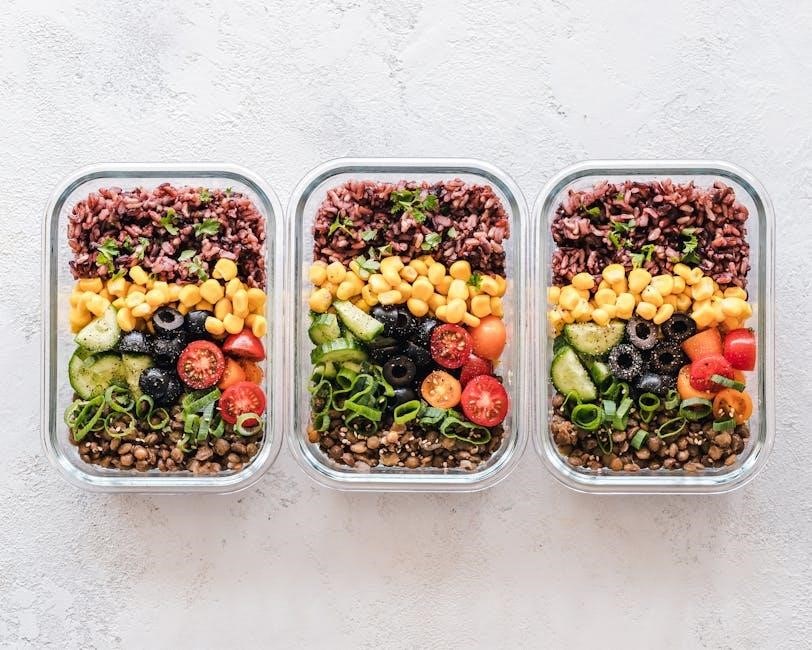Discover the metabolic confusion diet, a strategy to boost metabolism by varying calorie intake and macronutrients․ Ideal for endomorphs, this 7-day meal plan offers balanced meals to enhance weight loss and overall health․

How It Works
Metabolic confusion works by alternating high and low calorie days, varying macronutrient ratios to keep metabolism active and prevent adaptation, promoting sustained weight loss․
Calorie Variation
Calorie variation is a core strategy in metabolic confusion, involving alternating high and low calorie days to prevent the body from adapting․ This approach tricks the metabolism into staying active, preventing plateaus and promoting fat loss․ By fluctuating intake, the body remains in a fat-burning state, optimizing weight loss efforts․ Balanced nutrient distribution ensures satisfaction and energy, making it sustainable for endomorphs seeking effective weight management and improved metabolic health․
Macronutrient Cycling
Macronutrient cycling enhances metabolic flexibility by varying protein, carbohydrates, and fats․ This method keeps the body guessing, avoiding adaptation and boosting fat loss․ High-protein days support muscle retention, while carb cycling regulates energy and fat burning․ Balanced fat intake sustains hormones and satisfaction․ This strategic rotation optimizes metabolism, aiding endomorphs in achieving their weight goals effectively and maintaining overall health through diverse nutrient intake․

Benefits
The metabolic confusion diet prevents plateaus, boosts metabolism, and promotes steady weight loss while keeping you satisfied with nutrient-rich meals․
Weight Loss
Metabolic confusion effectively aids weight loss by preventing the body from adapting to a single diet pattern․ By cycling calories and macronutrients, it keeps metabolism active, avoiding plateaus․ This strategy ensures consistent fat burning, especially for endomorphs․ The varied meal plan keeps you satisfied, reducing overeating and cravings․ Sustainable and structured, it promotes steady weight loss while maintaining muscle mass, making it a reliable approach for achieving and maintaining a leaner physique over time․
Metabolism Boost
Metabolic confusion stimulates your metabolism by alternating calorie and macronutrient intake, preventing adaptation․ This keeps your metabolic rate high, enhancing fat burning and energy levels․ By challenging your body with varied dietary patterns, it avoids complacency, ensuring your metabolism remains efficient․ This approach not only aids in weight loss but also improves overall metabolic health, helping you maintain a faster metabolism long-term for better calorie burning at rest and during activity․

Sample 7-Day Meal Plan
A structured 7-day plan with breakfast, lunch, dinner, snacks, and desserts, alternating calorie and macronutrient intake to maximize metabolic benefits and provide balanced nutrition․
Day 1
Start with a high-calorie day to kickstart your metabolism․ Breakfast: Egg omelet with vegetables, whole-grain toast, and avocado․ Lunch: Grilled chicken salad with mixed greens, cherry tomatoes, cucumber, and olive oil dressing․ Dinner: Baked salmon, steamed broccoli, and quinoa․ Snacks: Greek yogurt with berries and a handful of almonds․ Stay hydrated with water throughout the day․ This balanced approach provides essential nutrients while supporting metabolic variation․
Day 2
Transition to a lower-calorie day to promote fat burning․ Breakfast: Oatmeal with sliced banana, almond butter, and a splash of low-fat milk․ Lunch: Grilled turkey and avocado wrap with mixed greens and a side of baby carrots․ Dinner: Grilled shrimp with roasted asparagus, bell peppers, and a small serving of brown rice․ Snacks: Hard-boiled eggs and a small apple․ Keep meals protein-rich and portions controlled to support metabolic variation and weight loss goals․
Day 3
Day 3 focuses on higher calorie intake with carb cycling․ Breakfast: Whole-grain pancakes with fresh berries and a drizzle of honey, plus a hard-boiled egg․ Lunch: Grilled lean chicken breast with roasted sweet potato and steamed green beans․ Dinner: Baked cod with quinoa and sautéed broccoli․ Snacks: Apple slices with peanut butter and a handful of mixed nuts․ This day emphasizes replenishing energy stores and maintaining metabolic balance with nutrient-dense meals․ Stay hydrated and monitor portion sizes for optimal results․
Day 4
Day 4 is a lower-calorie day, focusing on lean proteins and vegetables․ Breakfast: Scrambled eggs with spinach and mushrooms, plus a slice of whole-grain toast․ Lunch: Grilled turkey breast with a side of mixed greens and cherry tomatoes․ Dinner: Baked salmon with asparagus and a small portion of cauliflower rice․ Snacks: Sliced cucumber with hummus and a small handful of almonds․ This day helps reset calorie intake while maintaining nutrient density and metabolic balance․ Stay consistent with hydration and portion control to maximize results․
Day 5
Day 5 is a higher-calorie day to boost metabolism․ Breakfast: Oatmeal topped with berries, almond butter, and chia seeds․ Lunch: Grilled chicken breast with quinoa and steamed broccoli․ Dinner: Baked cod with roasted sweet potatoes and green beans․ Snacks: Apple slices with almond butter and a protein smoothie․ This day focuses on replenishing energy stores while maintaining a balance of proteins, carbs, and fats․ Ensure to stay hydrated and portion-controlled to support metabolic balance and weight loss goals effectively․
Day 6
Day 6 is a lower-calorie day to promote fat burning․ Breakfast: Scrambled eggs with spinach, tomatoes, and a slice of whole-grain toast․ Snack: Greek yogurt with mixed berries․ Lunch: Grilled turkey breast with a side of mixed greens and a small sweet potato․ Snack: One orange and a handful of almonds․ Dinner: Grilled shrimp with steamed asparagus and a half-cup of cauliflower rice․ Stay hydrated and focus on portion control to maintain metabolic balance and support weight loss efforts effectively;
Day 7
Day 7 is a high-calorie day to reset your metabolism․ Breakfast: Oatmeal with sliced banana, almond butter, and a splash of low-fat milk․ Snack: One medium apple with a tablespoon of almond butter․ Lunch: Grilled chicken breast with roasted vegetables and a small portion of quinoa․ Snack: A small handful of mixed nuts and a few dried apricots․ Dinner: Baked salmon with a side of steamed broccoli and a half-cup of sweet potato; Ensure hydration and portion control to maximize metabolic benefits and sustain energy levels throughout the day․

Foods to Include
Focus on whole, nutrient-dense foods: lean proteins like chicken and fish, complex carbs such as whole grains, and healthy fats like avocados and nuts․ Incorporate colorful vegetables, fruits, and fiber-rich foods to support metabolism and satiety․ Avoid processed items and opt for fresh, organic choices to maximize nutritional benefits and maintain energy levels․
Proteins
Include high-quality proteins like lean meats (chicken, turkey), fish (salmon, tilapia), and plant-based options (tofu, legumes)․ Eggs, Greek yogurt, and cottage cheese are excellent choices․ Opt for nitrate-free turkey bacon and lean beef for variety․ Protein shakes can supplement meals, ensuring adequate intake․ These options help maintain muscle mass and support metabolism, crucial for weight loss and overall health․ Prioritize organic and fresh sources to maximize nutritional benefits and avoid unnecessary additives․
Carbohydrates
Focus on complex carbs like whole grains (brown rice, quinoa, oats), vegetables (broccoli, spinach, bell peppers), and fruits (berries, apples, bananas)․ Include low-glycemic options to stabilize blood sugar․ Legumes, such as lentils and chickpeas, provide sustained energy․ Avoid refined carbs like white bread and pastries․ Incorporate a variety of colorful vegetables for fiber and nutrients․ These carbs support energy levels and metabolism, making them essential for balanced meals in the metabolic confusion plan․
Fats
Incorporate healthy fats like avocados, nuts, seeds, olive oil, and fatty fish (e․g․, salmon, mackerel) for essential fatty acids․ These fats support hormone production and satiety․ Opt for unsaturated fats to reduce inflammation and improve heart health․ Avoid processed and trans fats, which hinder progress․ Use portion control, as fats are calorie-dense․ Include a variety of sources to ensure a balanced intake and support metabolism․ Healthy fats are crucial for overall nutrition and weight management in the metabolic confusion plan․

Tips for Success

- Stay hydrated to boost metabolism and support digestion․
- Track progress to monitor changes and stay motivated․
- Avoid overeating to maintain calorie balance and prevent plateaus․
Stay Hydrated
Drinking enough water is crucial for metabolism and digestion․ Aim for at least 8 glasses daily to support your body’s functions․ Staying hydrated helps maintain energy levels, prevents hunger cravings, and ensures proper nutrient absorption․ Include water-rich foods like cucumbers and oranges in your meals․ Avoid sugary drinks and opt for herbal teas or lemon water for variety․ Keeping a water bottle handy can help you stay on track and maintain hydration throughout the day․
Track Progress
Monitoring your progress is essential for success․ Use a food diary or mobile app to log meals, portion sizes, and workouts․ Regularly track weight, measurements, and progress photos․ Adjust your calorie intake or macronutrient ratios based on results; Celebrate small victories to stay motivated and ensure consistency․ Tracking helps identify patterns and maintains accountability, leading to better adherence to the metabolic confusion meal plan and achieving your weight loss goals effectively․
Avoid Overeating
To prevent overeating, practice portion control by measuring food and using smaller plates․ Eat slowly and mindfully, savoring each bite to recognize satiety cues․ Plan snacks in advance to avoid grazing or consuming extra calories․ Stay hydrated, as thirst can masquerade as hunger․ Incorporate protein and fiber-rich foods to increase satiety and reduce cravings․ Avoid distractions like screens during meals to focus on your eating experience․ These strategies help maintain balance and prevent overconsumption, supporting your metabolic confusion meal plan’s effectiveness․
Metabolic confusion is a diet strategy that involves alternating calorie intake and macronutrient ratios to prevent the body from adapting, enhancing weight loss․ The 7-day metabolic confusion meal plan offers balanced, nutrient-dense meals tailored for endomorphs, helping break through fat loss plateaus․ By varying daily calories and nutrients, this approach boosts metabolism and supports sustainable weight loss․ The plan includes breakfast, snacks, lunch, dinner, and dessert options, ensuring variety and satisfaction while promoting overall health and wellness․
Metabolic confusion involves alternating high and low calorie days to keep your metabolism active, preventing plateaus by balancing proteins, carbs, and fats․
Calorie Cycling
Calorie cycling involves alternating between high and low calorie days to keep your metabolism active․ This prevents adaptation, boosting fat loss and avoiding plateaus․ For example, consuming 2,000 calories one day and 1,500 the next keeps your body guessing․ This strategy, part of the metabolic confusion meal plan, ensures your metabolism remains efficient, promoting sustained weight loss and improved energy levels․
Macronutrient Variation
Macronutrient variation involves changing the ratios of proteins, carbs, and fats to challenge your metabolism․ For example, one day may focus on high protein and low carbs, while another emphasizes complex carbs and healthy fats․ This approach prevents metabolic adaptation, enhancing fat loss and maintaining muscle mass․ By alternating macronutrient ratios, your body stays in a fat-burning state, leading to effective weight loss and improved overall health․
The metabolic confusion diet offers significant weight loss by boosting metabolism and breaking through plateaus․ It enhances fat loss while maintaining muscle, leading to a leaner physique․
Metabolic confusion promotes weight loss by alternating calorie intake, preventing metabolic adaptation․ This strategy helps break through plateaus, enhancing fat loss while preserving muscle․ By varying macronutrients and calories, the body stays in a fat-burning state, leading to consistent progress․ The plan includes high and low-calorie days, ensuring sustained weight loss without stagnation․ Balanced meals and nutrient-dense foods support overall health, making it easier to achieve and maintain a leaner physique over time․
Improved Metabolism
Metabolic confusion enhances metabolic efficiency by keeping the body adaptive․ Varying calorie and macronutrient intake prevents the metabolism from slowing down, fostering a more dynamic fat-burning process․ This approach encourages the body to remain in an active metabolic state, boosting energy levels and promoting long-term metabolic health․ By incorporating nutrient-dense foods, the diet supports optimal metabolic function, helping to maintain a faster metabolism and prevent plateaus, even during weight loss phases․
This structured plan offers daily meal ideas, alternating high and low calorie days to optimize metabolic confusion․ Includes breakfast, snacks, lunch, and dinner options for each day․
Start with an egg omelet, low-fat cheddar, and turkey bacon․ Mid-morning, snack on Greek yogurt with berries․ Lunch features a turkey and avocado sandwich with a side salad․ In the afternoon, enjoy apple slices with almond butter․ Dinner includes grilled chicken, steamed vegetables, and quinoa․ End the day with a dark chocolate square for dessert․ This balanced approach kickstarts your metabolic confusion journey, combining protein, healthy fats, and complex carbs to keep you satisfied and energized throughout the day․
Begin with oatmeal topped with sliced bananas, chia seeds, and a drizzle of honey․ Mid-morning, enjoy a handful of mixed nuts․ Lunch features grilled salmon, roasted asparagus, and a side of wild rice․ In the afternoon, snack on a cucumber and hummus plate․ Dinner includes lean turkey meatballs with zucchini noodles and marinara sauce․ End the day with a small serving of berries․ This day focuses on lean proteins, healthy fats, and fiber-rich carbs to support metabolism and energy levels throughout the day․
Start Day 3 with scrambled eggs, spinach, and a slice of whole-grain toast․ Mid-morning, enjoy a small apple with almond butter․ Lunch features grilled chicken breast, quinoa, and steamed broccoli․ In the afternoon, snack on raw vegetables with hummus․ Dinner includes baked cod, sweet potato wedges, and green beans․ End with a small piece of dark chocolate․ This day emphasizes lean proteins, complex carbs, and healthy fats to keep metabolism active and energy levels steady throughout the day․
Begin Day 4 with Greek yogurt topped with mixed berries and a sprinkle of chia seeds․ Mid-morning, snack on a handful of mixed nuts․ Lunch includes grilled turkey breast, brown rice, and steamed asparagus․ In the afternoon, enjoy a hard-boiled egg and baby carrots․ Dinner features baked salmon, quinoa, and roasted Brussels sprouts․ End the day with a small piece of dark chocolate․ This day focuses on lean proteins, fiber-rich vegetables, and balanced carbs to support metabolism and satisfaction․
Start Day 5 with scrambled eggs, spinach, and whole-grain toast․ Mid-morning, enjoy a small apple with a tablespoon of almond butter; Lunch features grilled chicken breast, quinoa, and sautéed broccoli․ In the afternoon, snack on a handful of mixed nuts and a few baby carrots․ Dinner includes baked cod, roasted sweet potatoes, and green beans․ End the day with a small square of dark chocolate․ This day emphasizes lean proteins, complex carbs, and healthy fats to keep metabolism active and energy levels steady․

Begin Day 6 with a veggie omelet, whole-grain toast, and a slice of avocado․ Mid-morning, snack on a small Greek yogurt with mixed berries․ Lunch features a turkey and avocado wrap with a side of mixed greens․ In the afternoon, enjoy two hard-boiled eggs and a handful of cherry tomatoes․ Dinner includes grilled salmon, roasted asparagus, and a small sweet potato․ Conclude the day with a small handful of mixed nuts․ This day focuses on lean proteins, healthy fats, and fiber-rich foods to support metabolism and satiety․
Start Day 7 with a protein-packed breakfast: scrambled eggs with spinach, a slice of whole-grain toast, and a small orange․ Mid-morning, snack on a small apple with a tablespoon of almond butter․ Lunch features a grilled chicken wrap with mixed greens and a side of sliced cucumbers․ In the afternoon, enjoy two hard-boiled eggs and a handful of cherry tomatoes․ Dinner includes baked cod, roasted broccoli, and a small portion of quinoa․ End the day with a small square of dark chocolate․ This day emphasizes lean proteins, fiber, and healthy fats to maintain metabolism and satisfaction․

Food Choices
Focus on nutrient-dense foods like lean proteins, complex carbs, and healthy fats to support metabolism and overall health․ Include a variety of colorful vegetables, whole grains, and lean proteins in your meals for optimal results․
Include lean proteins like chicken, turkey, fish, and eggs to support muscle maintenance and metabolism․ Plant-based options such as legumes, tofu, and quinoa are also excellent choices․ Opt for nitrate-free meats and wild-caught fish for better nutritional value․ Incorporate a variety of protein sources in each meal to ensure amino acid balance, which is crucial for muscle repair and growth․ Healthy preparation methods like grilling, baking, or steaming are recommended to avoid unnecessary calories and maximize nutritional benefits․
Carbs
Focus on complex carbohydrates such as whole grains, vegetables, and legumes to provide sustained energy and fiber․ Include brown rice, quinoa, oats, and sweet potatoes in your meals․ Non-starchy vegetables like broccoli, spinach, and bell peppers are excellent low-carb options․ Legumes, such as lentils and chickpeas, offer a balanced mix of carbs and protein․ Avoid refined sugars and processed grains to maintain metabolic balance and support weight loss․ Pair carbs with proteins and fats for a well-rounded diet․
Incorporate healthy fats like avocados, nuts, seeds, and olive oil to support hormone production and satiety․ Fatty fish such as salmon and mackerel provide omega-3 fatty acids, essential for overall health․ Use coconut oil or butter for cooking to add flavor and nutrients․ Avoid trans fats and excessive saturated fats․ Opt for portion-controlled servings to maintain calorie balance while reaping the benefits of these nutrient-dense foods․ Healthy fats are crucial for metabolic function and keeping meals satisfying․

Tips
Stay consistent with your meal plan, listen to your body, and adjust portions as needed․ Plan meals ahead to avoid last-minute unhealthy choices and ensure variety in nutrient-dense foods for sustained energy and satisfaction․
Hydration
Drinking plenty of water is essential for optimal metabolism and digestion․ Aim for at least 8 cups of water daily to support your body’s functions․ Staying hydrated helps suppress hunger, boosts energy levels, and enhances fat burning․ Incorporate herbal teas or infused water for variety without added calories․ Proper hydration also supports nutrient absorption and prevents overeating, making it a key component of your metabolic confusion diet success․ Track your water intake to ensure consistency and maximize results throughout your journey․
Portion Control
Managing portion sizes is crucial for maintaining calorie balance in a metabolic confusion diet․ Use smaller plates and measure food to avoid overeating․ Focus on balanced meals with protein, carbs, and fats․ Track portion sizes to ensure you’re meeting your daily calorie goals without excess․ This helps maintain the calorie cycling needed for metabolic confusion, supporting weight loss and preventing plateaus․ By controlling portions, you can enjoy variety while staying on track with your dietary plan․
Consistency
Consistency is key to achieving success with a metabolic confusion meal plan․ Stick to your daily calorie and macronutrient goals, even on weekends or holidays; Regularly track your progress to ensure you’re meeting your targets․ By maintaining a consistent routine, your body adapts to the calorie cycling, boosting metabolism and promoting steady weight loss․ Aim to plan meals in advance and avoid deviations to maximize results․ Over time, this consistent approach will help you achieve your desired physique and improve overall health․
A metabolic confusion meal plan is a powerful tool for breaking weight loss plateaus and enhancing metabolism․ By cycling calories and macronutrients, it keeps the body guessing, promoting fat loss․ The structured approach provides balanced meals and snacks, ensuring satisfaction while supporting goals․ Consistency and tracking are essential for success․ With dedication, this plan can transform your physique and improve overall health․ Stay committed, and consult a professional for personalized advice to maximize results and maintain long-term success;
